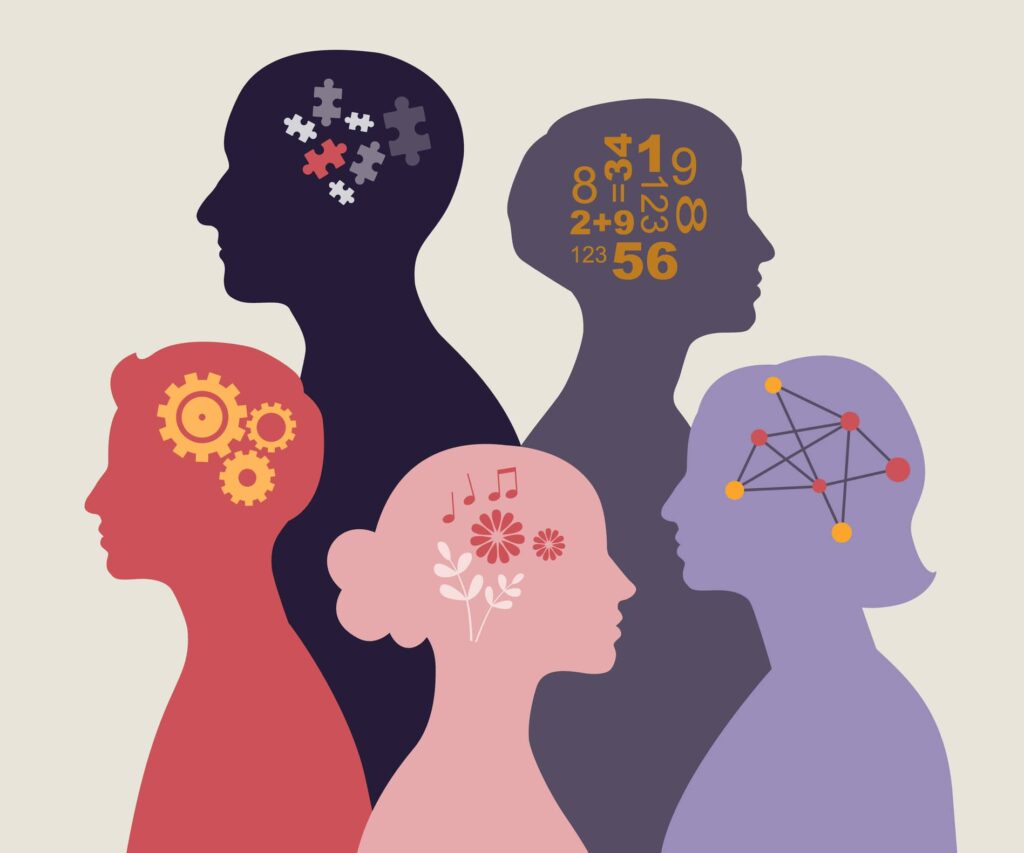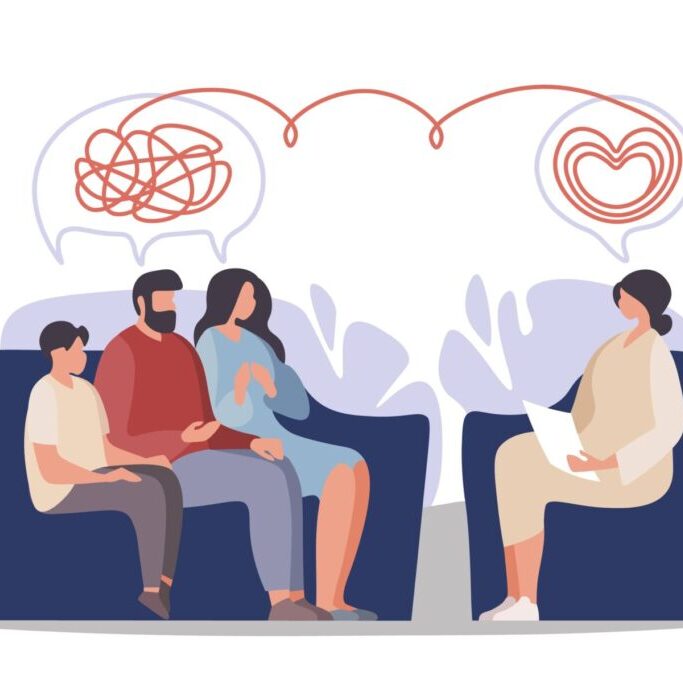Navigating Neurodiversity: A Journey Towards Affirming Assessment and Therapy

Imagine this: You’re embarking on a road trip, but your car has a unique GPS system. It doesn’t give the standard turn-by-turn directions; instead, it hums tunes that somehow guide you to your destination. While others might scratch their heads at your unorthodox method, it works perfectly for you. This quirky GPS is a metaphor for neurodiversity—a celebration of the unique ways our brains navigate the world.
As a psychologist in private practice, I often hear clients express relief when they realize that their “quirks” are not deficits but reflections of the incredible diversity in human thought and experience, brains that just work differently. Affirming mental health care is crucial to unlocking the potential of a neurodiverse brain.
Here I’ll give an overview of neurodivergent therapy and testing, exploring how affirming assessments and therapy can help you to better understand how your mind works and how to use that to your advantage in the world.
What Is Neurodiversity, and Why Does It Matter?
Neurodiversity is a concept that reframes conditions like autism, ADHD, dyslexia, and dyspraxia as natural variations in human cognition rather than pathologies to be “fixed.” Coined in the 1990s by sociologist Judy Singer, neurodiversity has become a rallying cry for celebrating different ways of thinking, learning, and processing the world.
It’s a bit like gardening. Not every plant thrives in the same soil, sunlight, or water conditions. Some require careful pruning, while others flourish with wild abandon. People who are neurodivergent—those whose brains function differently from the neurotypical majority—are like those unique plants, each needing tailored care to thrive.
By embracing neurodiversity, assessments and therapy can shift from focusing on deficits to building on strengths. This approach is not just empowering—it’s transformative.
Why Consider a Neurodiversity Assessment?
You may have read a fair number of blogs, listened to countless podcasts, or watched TikTok after TikTok about neurodiversity. The trouble is, by definition, neurodiversity is different for everyone.
That’s why the first step in understanding your neurodiversity is often through neurodiversity testing or assessment. These comprehensive evaluations can reveal the unique ways your brain processes information, paving the way for effective support.
Common Questions About Neurodivergent Testing
-
What does a neurodiversity assessment involve?
Testing typically includes interviews, questionnaires, and standardized tools to evaluate cognitive, social, and emotional functioning. Tests like the Autism Diagnostic Observation Schedule (ADOS-2) or the Conners Continuous Performance Test for ADHD offer insights into specific conditions.
-
Who should consider testing?
Testing is invaluable for anyone experiencing chronic challenges in focus, communication, or learning that hasn’t improved with traditional strategies. It’s also helpful for parents who notice their child struggling with tasks that seem easier for peers. Generally, if you know that you “get it,” but your experience just seems to be different than others, testing could be valuable to you.
-
What are the benefits of testing?
Think of testing as a blueprint. It provides a clear picture of strengths, challenges, and unique traits, enabling tailored strategies for success. Accurate testing can also help you access accommodations, such as extended test time for students or flexible work environments for professionals.
The Role of Neurodiversity-Affirming Therapy
Once testing provides a clearer understanding of a person’s neurodivergence, therapy steps in to support their goals. But here’s the catch—not all therapy is created equal! Neurodiversity-affirming therapy prioritizes empowerment over overcorrection. It’s about helping individuals embrace their authentic selves while navigating the world with greater ease.
What Makes Neurodiversity-Affirming Therapy Different?
- Strengths-Based Approach – Imagine your ADHD as a hyperactive puppy. It might chew your slippers, but it also brings boundless energy and enthusiasm. Instead of scolding the puppy, neurodiversity-affirming therapy helps you train it to focus on fetching what you truly value.
- Customized Goals – Neurodivergent therapy is not about forcing conformity but tailoring interventions to fit personal aspirations. For instance, a young adult with autism might work on strategies to succeed in a college environment while preserving their love for deep-focus activities like coding.
- Holistic Support – Therapy doesn’t stop at the doors of the office. A good therapist will advocate for accommodations at school, work, or home, ensuring the client’s environment supports their unique needs.
Real-Life Stories: Triumphs in Neurodivergent Therapy
A few examples of our own clients (names and identities changed and with their permission, of course).
First, Alex, a creative professional, came to therapy overwhelmed by deadlines. Neurodivergent testing revealed ADHD, but instead of focusing on “fixing” Alex’s distractibility, we explored their strengths—hyperfocus during creative bursts. By restructuring their work environment and using tools like time-blocking, Alex transformed stress into productivity.
Second, Jenna, a teenager diagnosed with autism, struggled with traditional social skills training. Instead of teaching her to “act neurotypical,” therapy celebrated her unique communication style. Through role-playing and leveraging her love for animals, Jenna built meaningful friendships without compromising her authenticity.
Take Action: Tips for People Who are Neurodivergent and Their Families
- Seek Comprehensive Assessment – Ensure that the evaluation goes beyond basic screeners. Look for clinicians who specialize in neurodiversity testing and consider co-occurring conditions like anxiety or dyslexia.
- Prioritize the Right Therapist – Ask potential therapists about their approach. Do they focus on deficits, or do they celebrate neurodiversity? A good fit is essential for building trust and fostering growth.
- Embrace Assistive Technology – From dictation software to noise-canceling headphones, technology can be a game-changer for neurodivergent individuals.
- Build a Supportive Network – Connect with advocacy groups, support communities, or even social media forums. Shared experiences can provide validation and resources.
The Science Speaks: Why This Matters
Recent research underscores the value of neurodiversity-affirming approaches. A 2022 study by Kapp and colleagues in Autism in Adulthood found that strengths-based therapy significantly improved life satisfaction for autistic adults. Similarly, a 2021 meta-analysis in Journal of Attention Disorders highlighted the effectiveness of individualized interventions in enhancing executive functioning for individuals with ADHD.
Celebrating Differences, Unlocking Potential
Neurodiversity reminds us that the human brain is like a symphony orchestra, where every instrument plays its own distinct part to create harmony and depth. Each neurotype—whether neurodivergent or neurotypical—contributes to the rich tapestry of human experience. Testing and therapy are not about “fixing” but about discovering, celebrating, and unlocking the full potential of each unique mind.
If you’re considering a neurodiversity assessment or therapy, know that you’re not alone on this journey. Together, we can navigate the complexities of neurodiversity and chart a path toward greater understanding, acceptance, and empowerment.
Are you ready to explore how neurodiversity-affirming therapy or testing can support your journey? Schedule today with the Tandem Psychology team. Together, let’s embrace the extraordinary possibilities of neurodiversity!
This blog is made for informational and educational purposes only. It is not medical advice. The information in this blog is not intended to (1) replace a one-on-one relationship with a qualified licensed health care provider, (2) create or establish a provider-patient relationship, or (3) create a duty for us to follow up with you.



